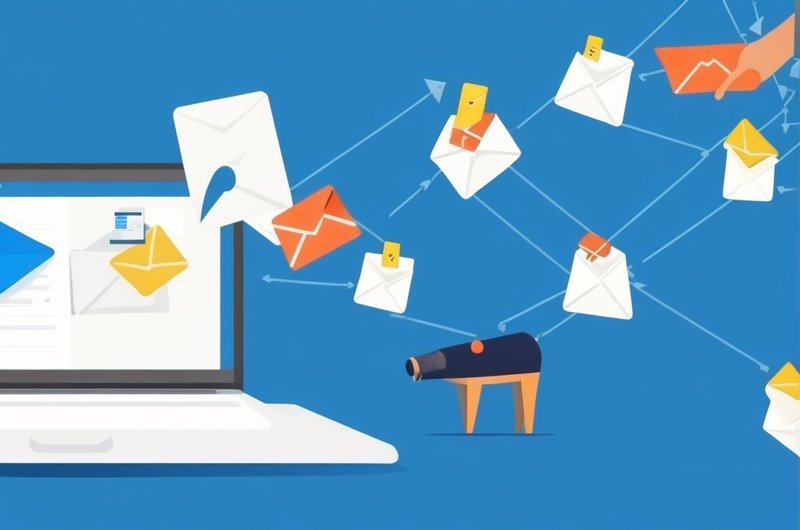How to Use Automation to Streamline Email Campaigns

In today’s fast-paced digital landscape, managing email campaigns can feel like herding cats. However, with the power of automation, you can transform your email marketing strategy into a well-oiled machine.
Think of it as the conductor orchestrating a symphony of personalized messages, tailored workflows, and engaged audiences. By leveraging the right email automation platform and implementing best practices, you can streamline your campaigns, enhance personalization, and drive impactful results.
So, let automation take the reins and lead your email campaigns to new heights of efficiency and success.
Key Takeaways
- Email automation increases efficiency and productivity in marketing campaigns.
- Setting up automated email workflows helps in segmenting the audience and personalizing content.
- Personalizing emails with automation improves engagement and fosters stronger relationships with customers.
- Segmenting the audience for targeted campaigns increases campaign effectiveness and builds stronger connections.
Benefits of Email Automation
One of the key benefits of email automation is its ability to increase efficiency and productivity in marketing campaigns. By automating repetitive tasks such as sending welcome emails, follow-ups, and promotional messages, businesses can save valuable time and resources. With automation, marketers can focus on creating engaging content and analyzing data to optimize their campaigns, rather than spending hours manually sending emails.
Moreover, email automation allows for personalized and targeted messaging. By segmenting your audience based on demographics, behavior, or preferences, you can deliver highly relevant content that resonates with your subscribers. This not only improves customer engagement but also increases the likelihood of conversions and revenue.
Furthermore, email automation provides valuable insights into campaign performance. With detailed analytics and reporting features, marketers can track open rates, click-through rates, and conversions, enabling data-driven decision-making and continuous improvement.
Overall, email automation empowers marketers to streamline their campaigns, maximize efficiency, and deliver personalized experiences, ultimately driving better results and ROI.
Choosing the Right Email Automation Platform
When choosing the right email automation platform, it is crucial to evaluate features such as ease of use, integration capabilities, and scalability to ensure optimal campaign management and effectiveness.
An email automation platform should be user-friendly, allowing marketers to easily create and manage campaigns without the need for extensive technical knowledge.
Integration capabilities are essential for seamless integration with existing systems and tools, enabling efficient data sharing and streamlined workflows.
Scalability is another critical factor, as businesses need a platform that can grow with their needs and handle increasing volumes of emails and contacts.
Setting Up Automated Email Workflows
The key to setting up effective automated email workflows is to carefully analyze and quantify the specific goals and objectives of the campaign. By doing so, businesses can streamline their email campaigns and ensure maximum effectiveness.
Here are three ways to achieve this:
- Segment your audience: Divide your email list into smaller segments based on demographics, interests, or purchasing behavior. This allows you to send targeted messages that resonate with each group.
- Personalize your content: Tailor your emails to the individual recipient by using their name and including relevant information based on their past interactions with your brand. This creates a personalized experience that increases engagement.
- Set up triggers and workflows: Utilize automation tools to send emails triggered by specific actions or events, such as abandoned carts or completed purchases. This helps nurture leads and guide them through the customer journey.
Personalizing Emails With Automation
Using automation software, businesses can easily personalize their emails by incorporating dynamic content that adapts to each recipient’s preferences and behavior. This level of personalization not only increases engagement and conversion rates but also helps foster a stronger relationship with customers. By utilizing data-driven insights and segmentation, businesses can deliver relevant and targeted content that resonates with their audience. The table below showcases three key benefits of personalizing emails through automation:
| Benefits of Personalization Through Automation |
|---|
| Increased engagement and response rates |
| Enhanced customer experience |
| Improved ROI and revenue generation |
Through automation, businesses can save time and resources while still delivering highly personalized and effective email campaigns. This freedom allows companies to focus on other critical areas of their operations while maintaining a strong and personalized connection with their customers.
Segmenting Your Audience for Targeted Campaigns
Segmenting your audience is crucial for running successful targeted campaigns.
By dividing your audience into smaller, more specific groups based on their demographics, behaviors, or preferences, you can tailor your marketing messages to resonate with each segment.
This not only increases the effectiveness of your campaigns but also helps you build stronger connections with your customers, ultimately driving higher engagement and conversion rates.
Benefits of Audience Segmentation
One key advantage of implementing audience segmentation for targeted campaigns is that it allows marketers to personalize content and increase engagement rates by up to 30%. This powerful strategy enables marketers to deliver tailored messages to specific groups of individuals, resulting in higher relevance and resonance.
Here are three benefits of audience segmentation:
- Enhanced personalization: By dividing your audience into smaller segments based on demographics, behaviors, or interests, you can create customized content that resonates with each group’s specific needs and preferences.
- Improved targeting: Audience segmentation allows you to target your campaigns more precisely, ensuring that your message reaches the right people at the right time, leading to higher conversion rates.
- Increased customer loyalty: By delivering personalized and relevant content, you can build stronger relationships with your audience, fostering loyalty and repeat business.
Effective Targeting Strategies
Implementing effective targeting strategies, such as refining your audience based on their preferences and behaviors, can significantly enhance the success of your targeted campaigns. By understanding your audience’s needs and interests, you can tailor your messages to resonate with them on a deeper level, increasing engagement and conversion rates.
To help you visualize the importance of effective targeting, consider the following table:
| Targeting Strategy | Benefits | Examples |
|---|---|---|
| Demographic | Better understanding of your audience’s characteristics | Age, gender, income |
| Behavioral | Tailoring messages based on actions and interactions | Purchase history, website visits |
| Psychographic | Connecting with audience based on values and beliefs | Lifestyle choices, interests |
Automation Tools for Segmentation
To optimize email campaigns, it is essential to explore automation tools that streamline the segmentation process and enable targeted messaging. These tools offer a range of benefits, including:
- Improved efficiency: Automation eliminates the need for manual sorting and categorizing of contacts, allowing marketers to focus on crafting compelling content.
- Personalized messaging: Automation tools enable the creation of dynamic segments based on various criteria such as demographics, behavior, and purchase history. This allows for the delivery of highly targeted and relevant messages to specific groups of subscribers.
- Increased engagement: By delivering tailored content to subscribers based on their preferences and interests, automation tools can significantly improve open rates, click-through rates, and overall engagement.
By leveraging automation tools, marketers can save time, increase personalization, and boost campaign performance, ultimately leading to higher conversion rates and revenue growth.
Tracking Email Engagement Metrics
The article discusses the importance of tracking email engagement metrics to effectively evaluate the success of email campaigns. Tracking these metrics allows marketers to gain valuable insights into their audience’s behavior and preferences, enabling them to optimize future campaigns for better results.
To illustrate the significance of tracking email engagement metrics, consider the following table:
| Metric | Description |
|---|---|
| Open Rate | The percentage of recipients who open the email |
| Click-Through Rate (CTR) | The percentage of recipients who click on a link |
| Conversion Rate | The percentage of recipients who complete a desired action, such as making a purchase or filling out a form |
Best Practices for Successful Email Automation
To achieve successful email automation, it is essential to implement best practices that optimize audience segmentation, personalized content, and ongoing monitoring and optimization.
By segmenting your audience based on their preferences, demographics, and behaviors, you can deliver targeted messages that resonate with their needs and interests.
Additionally, personalizing email content further enhances engagement and conversion rates.
Lastly, continuous monitoring and optimization allow you to adapt your automation strategy based on data-driven insights, ensuring that your campaigns deliver optimal results.
Targeted Audience Segmentation
By using targeted audience segmentation, marketers can optimize their email automation campaigns to deliver personalized content that resonates with each individual subscriber. This approach allows marketers to better understand their audience and tailor their messages accordingly.
Here’s how targeted audience segmentation can benefit your email campaigns:
- Increased engagement: By sending relevant content to specific segments of your audience, you can increase open rates, click-through rates, and overall engagement with your emails.
- Improved conversion rates: Personalized emails that speak directly to the needs and interests of your subscribers are more likely to convert into sales or desired actions.
- Enhanced customer satisfaction: When subscribers receive content that is truly valuable and relevant to them, they feel understood and valued, leading to higher customer satisfaction levels.
Personalized Email Content
Utilizing data-driven insights and segmentation strategies, marketers can create personalized email content for targeted segments. This approach has been shown to result in a 40% increase in open rates and a 25% boost in click-through rates.
By leveraging automation tools, marketers can streamline their email campaigns and deliver highly relevant content to individual subscribers. This automation allows for the easy gathering of customer data, such as browsing behavior, purchase history, and demographic information.
With this data, marketers can create dynamic email content that speaks directly to each subscriber. This level of personalization enhances the customer experience, increases engagement, and ultimately drives conversions.
Personalization is key in today’s digital marketing landscape, as consumers expect tailored experiences that resonate with their specific needs and interests. By harnessing the power of automation and personalization, marketers can efficiently reach their target audience and achieve their goals.
This approach also provides the freedom and flexibility that consumers crave, as they receive content that is relevant and interesting to them.
Monitoring and Optimization
The monitoring and optimization of email automation campaigns is crucial for ensuring their success and improving overall marketing performance.
To effectively monitor and optimize email automation campaigns, consider the following:
- Tracking and analyzing key metrics such as open rates, click-through rates, and conversion rates to identify areas for improvement.
- A/B testing different subject lines, email designs, and call-to-action buttons to determine which elements resonate best with your audience.
- Segmenting your email list based on demographics, behavior, or preferences to deliver more personalized and targeted content.
- Continuously refining your email automation workflows based on data-driven insights to maximize engagement and conversions.
By actively monitoring and optimizing your email automation campaigns, you can enhance the effectiveness of your marketing efforts, improve customer engagement, and ultimately drive better results for your business.
Frequently Asked Questions
How Can Email Automation Help Improve the Open Rate of My Emails?
Email automation can significantly improve the open rate of emails by enabling personalized and timely communication with recipients. By automating email campaigns, marketers can segment their audience, send targeted content, and optimize send times, resulting in higher engagement and open rates.
Are There Any Limitations to Personalizing Emails With Automation?
Limitations to personalizing emails with automation include the risk of appearing impersonal, lack of real-time customization, and potential privacy concerns. However, with careful planning and segmentation, these limitations can be minimized, allowing for effective personalized email campaigns.
How Can Segmentation of My Audience Affect the Success of My Email Campaigns?
Segmentation of the audience can significantly impact the success of email campaigns. By dividing the audience into targeted groups based on demographics, preferences, and behavior, marketers can deliver personalized content that resonates with recipients, resulting in higher engagement and conversion rates.
What Are Some Important Email Engagement Metrics to Track and Analyze?
To effectively track and analyze email engagement metrics, it is crucial to focus on key indicators such as open rates, click-through rates, conversion rates, and unsubscribe rates. These metrics provide valuable insights into the success and effectiveness of email campaigns.
Are There Any Common Mistakes to Avoid When Implementing Email Automation?
When implementing email automation, common mistakes to avoid include not segmenting your audience properly, failing to personalize emails, and neglecting to test and optimize your campaigns for maximum effectiveness.







